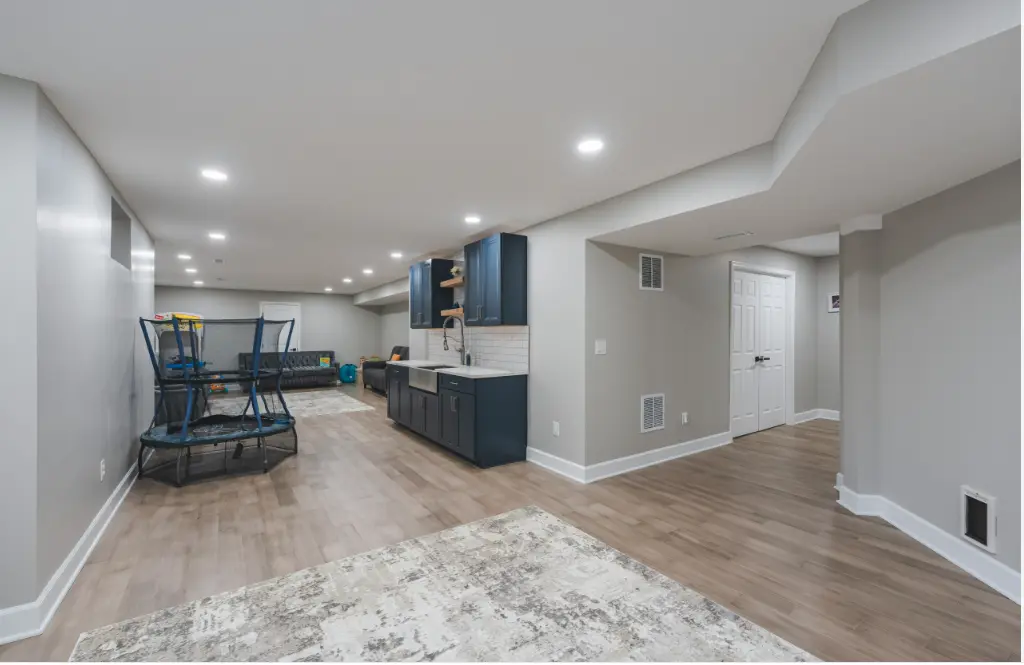The basement is more than just a space for storing unused items or doing laundry. Currently, many homeowners are converting their basements into functional and living spaces. Before you join this growing trend, here are six essential things you should know before remodeling your basement.
The latest nationwide research reports that basement remodels are among the best investments you can make in your home, adding approximately 70 cents per dollar spent to your home’s resale value. Turn it into a square footage you need and use. And it will more than pay off when it comes time for you to pack up and move out.
Keep reading for six questions you need to answer before you start remodelling your basement.
What Is Your Home Worth?
To figure out how much it makes sense to spend, look at your financing options, comparable homes in your neighbourhood, especially ones that have sold recently with finished or remodelled basements, and a recent appraisal of your own home. Smart move will be to go with durable, neutral fixtures that will stand up to time.
The resale value isn’t a big concern if this is a forever home, go ahead and spend your money where it matters most to you. Fancy wet bar? Massive movie theatre? Go for it. It might also make financial sense for you to make spendy improvement. So that your house better suits your family and your lifestyle.
How Is The Structure Holding Up For Remodeling Your Basement?
Basement is the foundation of your house so before you start a remodelling project, carefully examine every inch. Remember that it is not just a new living room waiting to be realised. Look for cracks in the walls and floors, puddling water and slow leaks, sagging ceilings and suspicious plumbing or electrical issues. Most problems can be fixed. But you’ll need to have them examined by a professional contractor and possibly a structural engineer in order to figure out a safe, long-term, cost-effective solution.
Smart move will be to plan for things to go wrong,while you’re remodelling your basement. Both during the project and in the years to come. Earmark part of your budget for must-fix emergencies that crop up and be sure to choose fixtures that can withstand damage. Mould-proof paint, waterproof flooring and slip-covered furniture can make life a little easier (and less expensive) when you’re in clean-up mode.
What Kind of Water You Dealing With?
Let me make it clear, if you have a basement that is at least partially below ground, you are going to be dealing with moisture.
Since most basements are built on a concrete slab that sits directly on dirt, wetness seeps up from the ground and moves through the porous concrete. This can cause anything from mild humidity in the air to inch-deep puddles. Because basement walls also tend to be made from concrete blocks, water can seep in here, too. And if there’s a crack in your wall or a weak seal around an exterior window or door, those are potential problems!
Solution will be to do pre-modelling. Spend $30 on a moisture metre to check out your existing fixtures and furnishings, if you’re going to remodel an already- finished basement space. You can also pick up a hygrometer to measure indoor humidity levels for about $10.
Many leaks are caused by runoff water being directed toward your home’s foundation or rainwater collecting around your house because there’s nowhere else for it to go. So you should rethink the drainage system on the outside of your house. Installing French drains may be the reason for redirecting water that could cause leaks inside your basement.

What Does Your Town Require?
There are several rules of cities that you need to follow, even for a basic basement remodelling. Because of city recruitment you might not have everything you got planned, such as a party room.
These codes can dictate everything from the height of your ceiling to the width of your hallways and the construction of your staircase. They may or may not allow you to build a full kitchen or may limit the types of appliances you can install. They’ll also specify what sorts of exits, including emergency exits, your finished basement needs to have.
For example, if the goal of your basement is to create a rentable living space, three could be additional requirements tracked on. Such as separate thermostats, electric panels and water metres are common building code-mandated necessities.
How Much Space Are You Working With?
Ceiling height is a make-or-break element for lots of basements. According to the International Residential Code, ceilings in basements must be a minimum of seven feet tall. You should check your local building code too, to ensure that it does not impose additional height requirements.
So, there are several ways to make a basement ceiling higher, but they will add a bundle to your bottom line. You might be able to…
● Reroute ducting that could hinder your intended living space
● Raise or replace existing structural beams
● Dig out the existing floor and lower it
If your home does have low (but livable) ceilings, do what you can to make them seem as high as possible. Avoid ceiling fans and install recessed lights rather than flush- or semi-flush-mount fixtures. Skip the crown mouldings and decorative trim, as they can narrow a space.
Sometimes, saving an inch are two can make a big difference.
How Will You Really Use The Space?
There are so many different options you could do with your basement. However, there’s often a difference between what would look nice in a space and its most practical function.
You have to be honest with yourself about what your family will and won’t do and ask you some questions. Such as: Will your young kids go downstairs by themselves to play? Do you have enough guests to justify a remodelled suite? Could you satisfy your wine obsession with a beverage cooler instead of a wine cellar? Will you head downstairs for your morning workout six months from now? How often are you really going to use that in-home movie theatre? Even if the answer is “every weekend,” the best choice might not be a row of black recliners and a wall-sized projection screen.
In a conclusion, perfectly made basement expands your little world called home. And be the cause of cosy nights and become a memory maker place for your friends and family.
Take a look at our recent projects It would be a pleasure to make your dreams come true, your Elegant Kitchen & Bath.
6 Things to Know Before Remodeling Your Basement: FAQs
1. What are the key considerations for basement remodeling?
What should I consider before starting my basement remodeling project?
Before starting your basement remodeling project, consider the following key points:
– Purpose of the Space: Decide on how you plan to use the remodeled basement, whether as a playroom, TV space, or additional living area.
– Moisture and Waterproofing: Basements are prone to moisture; ensure proper waterproofing measures are in place to prevent mold and water damage.
– Ceiling Height and Space: Check if the ceiling height meets code requirements after adding flooring and ceiling finishes.
– Egress Requirements: For safety, ensure that your basement has proper egress windows or doors in case of emergencies.
– HVAC and Electrical Systems: Consider whether your current HVAC and electrical systems can support the additional space.
– Permits and Codes: Research local building codes and obtain necessary permits before starting work.
2. How can I ensure my basement remodeling is cost-effective?
What steps can I take to keep my basement remodeling project within budget?
To ensure cost-effectiveness:
– Get Multiple Quotes: Obtain quotes from several contractors to compare prices and services.
– DIY Where Possible: Consider which aspects of the remodeling you can do yourself to save on labor costs.
– Prioritize Needs Over Wants: Focus on essential renovations first and optional ones as budget allows.
– Choose Materials Wisely: Opt for materials that offer a good balance between quality and cost.
– Plan for the Unexpected: Allocate a portion of your budget for unforeseen expenses during the remodeling process.
3. What are common mistakes to avoid in basement remodeling?
What are some common pitfalls in basement remodeling and how can I avoid them?
Common mistakes include:
– Ignoring Moisture Issues: Ensure proper waterproofing to prevent mold and water damage.
– Poor Planning: Lack of a clear plan can lead to cost overruns and delays. Plan thoroughly before starting.
– Overlooking Ventilation: Basements need good ventilation to prevent air quality issues.
– Not Adhering to Code: Failing to comply with local building codes can result in fines and having to redo work.
– Underestimating Costs: Be realistic about costs and include a buffer for unexpected expenses.
4. How long does it typically take to remodel a basement?
What is the average timeline for a basement remodeling project?
The timeline can vary widely based on the scope of the project, but it generally takes several weeks to several months. DIY projects may take longer, especially if working on it part-time[17]. Hiring professionals can expedite the process, but availability and the complexity of the work can affect the timeline.
5. Do I need a permit to remodel my basement?
Is a permit required for basement remodeling?
Yes, in most cases, you will need a permit, especially if you’re making structural changes, adding egress windows, or altering the plumbing or electrical systems. Check with your local building department for specific requirements.
6. How can I ensure good air quality in my remodeled basement?
What measures can I take to maintain healthy air quality in my basement?
To ensure good air quality:
– Install Adequate Ventilation: Consider adding windows or a ventilation system.
– Control Moisture: Use dehumidifiers and ensure proper waterproofing to prevent mold growth.
– Choose Low-VOC Materials: Opt for paints, adhesives, and finishes that emit fewer volatile organic compounds (VOCs).
– Regular Maintenance: Keep the basement clean and regularly inspect for any signs of mold or moisture issues.
